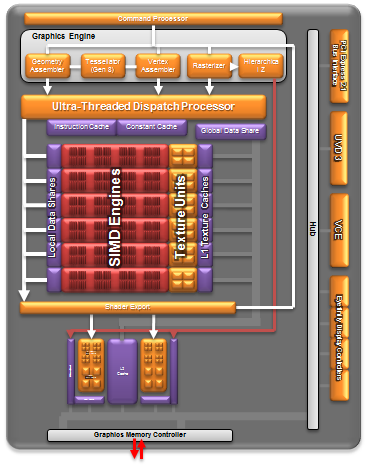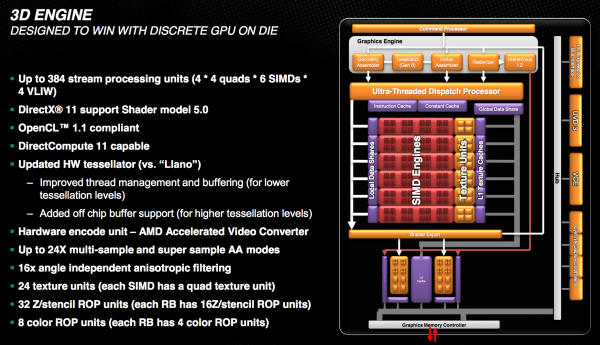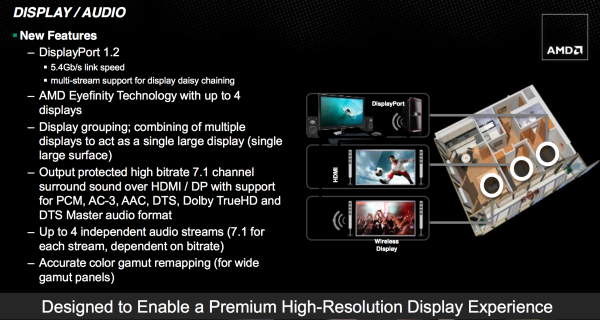The AMD Trinity Review (A10-4600M): A New Hope
by Jarred Walton on May 15, 2012 12:00 AM ESTImproved Turbo
Trinity features a much improved version of AMD's Turbo Core technology compared to Llano. First and foremost, both CPU and GPU turbo are now supported. In Llano only the CPU cores could turbo up if there was additional TDP headroom available, while the GPU cores ran no higher than their max specified frequency. In Trinity, if the CPU cores aren't using all of their allocated TDP but the GPU is under heavy load, it can exceed its typical max frequency to capitalize on the available TDP. The same obviously works in reverse.
Under the hood, the microcontroller that monitors all power consumption within the APU is much more capable. In Llano, the Turbo Core microcontroller looked at activity on the CPU/GPU and performed a static allocation of power based on this data. In Trinity, AMD implemented a physics based thermal calculation model using fast transforms. The model takes power and translates it into a dynamic temperature calculation. Power is still estimated based on workload, which AMD claims has less than a 1% error rate, but the new model gets accurate temperatures from those estimations. The thermal model delivers accuracy at or below 2C, in real time. Having more accurate thermal data allows the turbo microcontroller to respond quicker, which should allow for frequencies to scale up and down more effectively.
At the end of the day this should improve performance, although it's difficult to compare directly to Llano since so much has changed between the two APUs. Just as with Llano, AMD specifies nominal and max turbo frequencies for the Trinity CPU/GPU.
A Beefy Set of Interconnects
The holy grail for AMD (and Intel for that matter) is a single piece of silicon with CPU and GPU style cores that coexist harmoniously, each doing what they do best. We're not quite there yet, but in pursuit of that goal it's important to have tons of bandwidth available on chip.
Trinity still features two 64-bit DDR3 memory controllers with support for up to DDR3-1866 speeds. The controllers add support for 1.25V memory. Notebook bound Trinities (Socket FS1r2 and Socket FP2) support up to 32GB of memory, while the desktop variants (Socket FM2) can handle up to 64GB.
Hyper Transport is gone as an external interconnect, leaving only PCIe for off-chip IO. The Fusion Control Link is a 128-bit (each direction) interface giving off-chip IO devices access to system memory. Trinity also features a 256-bit (in each direction, per memory channel) Radeon Memory Bus (RMB) direct access to the DRAM controllers. The excessive width of this bus likely implies that it's also used for CPU/GPU communication as well.
IOMMU v2 is also supported by Trinity, giving supported discrete GPUs (e.g. Tahiti) access to the CPU's virtual memory. In Llano, you used to take data from disk, copy it to memory, then copy it from the CPU's address space to pinned memory that's accessible by the GPU, then the GPU gets it and brings it into its frame buffer. By having access to the CPU's virtual address space now the data goes from disk, to memory, then directly to the GPU's memory—you skip that intermediate mem to mem copy. Eventually we'll get to the point where there's truly one unified address space, but steps like these are what will get us there.
The Trinity GPU
Trinity's GPU is probably the most well understood part of the chip, seeing as how its basically a cut down Cayman from AMD's Northern Islands family. The VLIW4 design features 6 SIMD engines, each with 16 VLIW4 arrays, for a total of up to 384 cores. The A10 SKUs get 384 cores while the lower end A8 and A6 parts get 256 and 192, respectively. FP64 is supported but at 1/16 the FP32 rate.

As AMD never released any low-end Northern Islands VLIW4 parts, Trinity's GPU is a bit unique. It technically has fewer cores than Llano's GPU, but as we saw with AMD's transition from VLIW5 to VLIW4, the loss didn't really impact performance but rather drove up efficiency. Remember that most of the time that 5th unit in AMD's VLIW5 architectures went unused.
The design features 24 texture units and 8 ROPs, in line with what you'd expect from what's effectively 1/4 of a Cayman/Radeon HD 6970. Clock speeds are obviously lower than a full blown Cayman, but not by a ton. Trinity's GPU runs at a normal maximum of 497MHz and can turbo up as high as 686MHz.
Trinity includes AMD's HD Media Accelerator, which includes accelerated video decode (UVD3) and encode components (VCE). Trinity borrows Graphics Core Next's Video Codec Engine (VCE) and is actually functional in the hardware/software we have here today. Don't get too excited though; the VCE enabled software we have today won't take advantage of the identical hardware in discrete GCN GPUs. AMD tells us this is purely a matter of having the resources to prioritize Trinity first, and that discrete GPU VCE support is coming.















271 Comments
View All Comments
texasti89 - Tuesday, May 15, 2012 - link
A10-4600M's TDP = 35W
I7-3720QM's TDP = 45W
I'm pretty sure that Intel's 22nm is more power efficient that any 32nm process available in the industry. The efficiency of Intel GPU architecture is what makes their graphic solution appears to be comparable to AMD fusion parts.
Lolimaster - Tuesday, May 15, 2012 - link
As obviously with the biased reviewers.Yeah GJ. Compare a top of the line UBER-expensove IB quad core with the highest TDP and the highest frequency vs A10 Trinity wich costs 3times less(if not more) thant that i7 3720QM.
HD4000 performance is craptastic. Don't fool people with biased comparisons, at medidum detail and low res, cpu take advantage. For mobile each Mhz towards the 3Ghz and above improve performance.
BUT WE ARE TALKING ABOUT AN i7 IB 3x times MORE EXPENSIVE than Trinity with WAY HIGHER MHZ. It's not the pathetic HD4000 that is shining is just the cpu, you can put an HD6450M and it will appear "faster" than Trinity if you pair with a high end expensive cpu.
It's like the moronic reviews with a i7 3770K ($300+) vs A8-3870K ($120).
Everyone knows that the real competion are the dual core i5 and similar price.
And again, medium details when APU's prooved to offer high quality in most games.
JarredWalton - Tuesday, May 15, 2012 - link
http://www.anandtech.com/bench/Product/600?vs=580I've got Mainstream and Enthusiast performance results in there for the games, but there's not much point in running games at 1600x900 High settings at <30 FPS is there?
I have a whole section stating why we're including the systems we're including. Are you seriously delusional enough to suggest that we not show HD 4000 performance? There are no other HD 4000 results available for the time being, so either I use the i7-3720QM or I omit Ivy Bridge entirely. For you to imply its inclusion (with the note--italicized even!--that "these two laptops do not target the same market") is somehow biased is in fact far more bias than anything I've shown. And the pricing is twice as high for the ASUS system, not three times -- in fact I'd guess the Trinity laptop would be closer to $800 as configured, since it has Blu-ray and an SSD.
What's more, throughout the review, I've included dual-core i5-2410M results and discussed how AMD's Trinity stacks up. Judging by Sandy Bridge, dual-core Ivy Bridge will be within 10% of the quad-core scores for gaming--it's not like many games can use more than two CPUs, and so it's really just a matter of the HD 4000 clocks being slightly lower on i5 models. You fail to grasp this fact with your ranting and biased outlook, unfortunately.
In other words, I think your "moronic reviews" comment reflects your reading comprehension skills--or lack there of. Better luck next time. You might want to sign up for the remedial math and basic reading classes at the local community college.
kyuu - Tuesday, May 15, 2012 - link
"I've got Mainstream and Enthusiast performance results in there for the games, but there's not much point in running games at 1600x900 High settings at <30 FPS is there?"Is that that the FPS you get? Did you actually test this or just assuming? Also, you can run 1600x900 without automagically turning up the detail settings to High at the same time. I, for one, am interested to see if the performance advantage increases over Llano/HD4000 when you shift more of the burden to the GPU side. At x768, it seems like the CPU would still be handling enough to make the CPU a substantial bottleneck.
JarredWalton - Tuesday, May 15, 2012 - link
Yes, the scores in Mobile Bench are all actually tested -- including the 5 FPS average score of Trinity at 1920x1080 with 4xAA in Battlefield 3. (Yes, watching that made me feel a bit nauseous....) I could test 1600x900 at medium detail, but I don't expect any major changes from what the existing scores show.Denithor - Tuesday, May 15, 2012 - link
Actually those facts are very interesting to some of us! It lays out what the system can/cannot handle in practical terms. Now, granted, BF3 @ 1080p/4xAA is kinda an obvious fail scenario, but 1080p medium detail might be good to know.One real question that I haven't seen mentioned yet - how come there were no Intel cpu + nVidia gpu systems included in this testing? That seemed like a no-brainer to me...
JarredWalton - Wednesday, May 16, 2012 - link
I thought the Acer TimelineU was a good choice. The only other recently tested laptops with Intel + NVIDIA are the Razer Blade (if people complain that N56VM is too expensive, what would they say about a $3500 laptop!?) and the Alienware M17x R3 (completely different class of hardware and again over $2000). The others like Dell XPS 15z came before we changed our game list, so we don't have some of the results for such laptops.vegemeister - Tuesday, May 15, 2012 - link
CPU speed doesn't become significant at low resolution because the resolution is low, but because the frame rate is high. The CPU must create the scene to be rendered at much higher temporal resolution.bji - Tuesday, May 15, 2012 - link
I think this was a well written article and that you laid out the facts about as clearly as could be laid out. I agree that Lolimaster has poor reading comprehension and needs some remedial education.raghu78 - Tuesday, May 15, 2012 - link
OEM laptop pricing is what changes the discussion. Also the sandybridge stock clearing firesale is a crucial factor. Given that core i7 2630qm with nvidia GT 555M is at USD 800 and entry level core i5 laptops at USD 550http://www.newegg.com/Product/Product.aspx?Item=N8...
http://www.newegg.com/Product/Product.aspx?Item=N8...
The A10 trinity laptops need to come at USD 600 with a max of 650 for the best designs, with the A8 at 500- 550 and the A6 / A4 at USD 400 - 450.Then they can clearly avoid competing core i7 with discrete GPU configs and be considered good alternatives for the low end Intel core i5, core i3 and pentium/ celeron dual cores with crappy intel HD 3000 graphics. Not to forget the the GPU drivers advantage which AMD has, very good image quality and a rapidly growing GPU accelerated apps ecosystem.